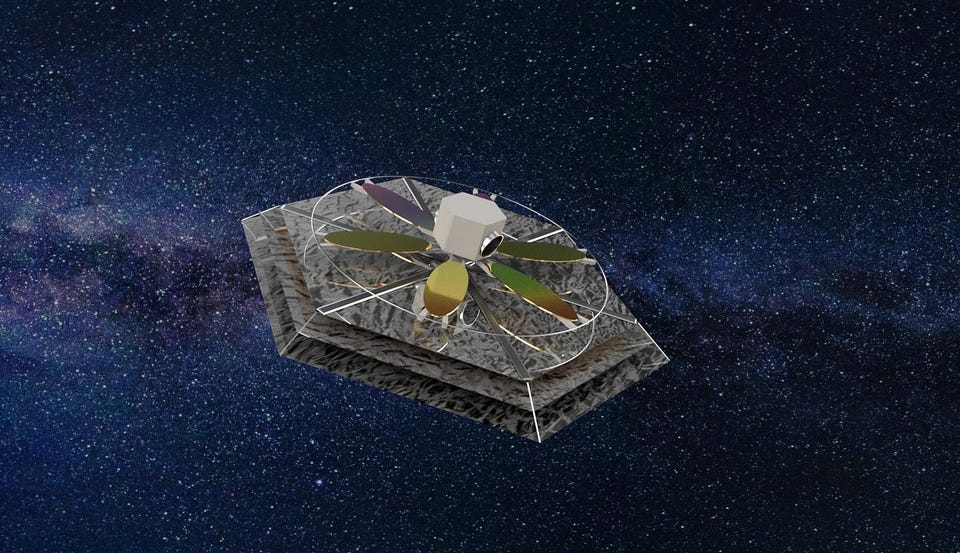NASA Funds Disruptive Space Tech To Detect Very Nearby ExoEarths


A disruptive new planet-hunting technology, now under study as part of NASA’s Innovative Advanced Concepts (NIAC) program, could literally detect and then look for biosignatures from every Earth 2.0 within a thirty-light-year radius of our solar system.
Known as DICER (The Diffractive Interfero Coronagraph Exoplanet Resolver), the key to this NIAC study’s revolutionary means of detecting these planets is that unlike conventional optical space telescopes —- which use curved, highly polished mirrors to collect starlight —- this mission would employ flat sets of what are known as diffraction gratings.
These gratings would act as super prisms to redirect the starlight that hits them onto smaller curved mirrors. This would not only vastly reduce the infrared telescope’s weight, but it would also make such a high-resolution exoplanet mission cost-efficient.
We have a baseline design that uses three sets of two gratings, Heidi Jo Newberg, an astrophysicist at Rensselaer Polytechnic Institute in Troy, New York and DICER’s project lead, told me via email. Each set of two 10-meter-long gratings can detect light in a small part of the emission spectrum from an exoplanet, says Newberg, the recipient of a $175,000 ‘Phase I’ NIAC Fellowship.
By precisely aligning these gratings, the observatory would achieve the equivalent resolution of a 20-meter optical space telescope.
This new DICER technology won’t exactly produce pretty pictures of the planets it may detect. But it should enable Newberg and colleagues to garner enough spectra to detect exoearths in a star’s habitable zone. That’s currently defined as where a planet can maintain liquid water at its surface.
The mission’s coronagraph would enable these detections by removing all the starlight in the center of the field of view of the telescope. Thus, any earthlike planet close-in to the star could actually be detected.

If this initial nine-month study succeeds, the team can then apply for a two-year $600,000 Phase II study. The hope is that this estimated $1 billion dollar DICER mission would see full development over the next decade.
Unlike previous extrasolar planet-hunting techniques, DICER would be capable of finding and studying planets at all inclinations, including face-on orbits. And it would be capable of determining whether a planet has an atmosphere that harbors ozone (O3), a telltale signature of oxygen.
The observatory would be sent to the gravitationally-stable Sun-Earth Lagrange point 2 (L2), located about a million miles from Earth. It would be operational for at least a few years as the mission would require enough time to detect a planet like our Earth orbiting its parent star.
Although terrestrial type planets are easier to detect around smaller red dwarf (M) stars which dominate the nearby galaxy, this proposed new mission concept would target so-called G and K type stars, which are more akin to our Sun.
G and K stars are long-lived and do not have large magnetic storms that would disturb a planet in the habitable zone in the way M stars do, says Newberg. Exoplanets in the habitable zone of M stars are also more likely to be tidally locked (so that the same side faces the host star), which would make the weather patterns drastic, she says.
Thus, G and K stars may be the sweet spot.
K stars are the dimmest of the more stable main sequence stars, says Newberg. But the Sun is a G star, which is a little more massive and brighter than a K star, she says. And it is the only star we know that hosts intelligent life, says Newberg. That’s why we are designing DICER to find exoearths around G and K stars, she says.
Even so, the team has a daunting task ahead.
Think about how difficult it is to find a planet that is as small as Earth around a star that is millions or billions of times brighter, says Newberg. Then imagine spreading the tiny amount of light that reaches us from that planet into a spectrum, she says.

There are 62 known G and K stars that lie within 33 light-years of Earth. Only one, Tau Ceti, is known to host either a super-earth or a mini-Neptune.
We don’t know how many habitable exoplanets DICER would find; it could be zero or it could be fifty, says Newberg. If we find earth-like exoplanets and then find oxygen, there’s a good chance that it was produced by life, she says. That is the sort of discovery that would prompt another mission to just probe that planet, says Newberg. If we find earth-like exoplanets and don’t find oxygen, then there could still be anaerobic life, she notes.
As for launch?
The optimistic timescale is 2033 using a Falcon Heavy rocket, says Newberg.
But at this stage, the mission concept is very much in flux.
The team is weighing options to maximize the concept’s science while also trying to simplify the spacecraft’s mechanical system. It’s a process that takes into consideration what Newberg terms the usual tradeoff between time, cost, and scientific productivity.
The mission’s first priority is to simply find these hidden exoearths then look for ozone.
Ozone is the biosignature that we think would be easiest to find, says Newberg. But we also might consider looking for methane, carbon dioxide, and water, she says.
